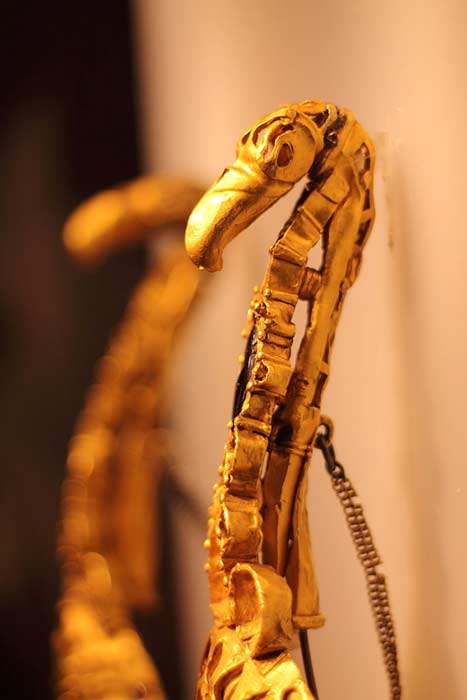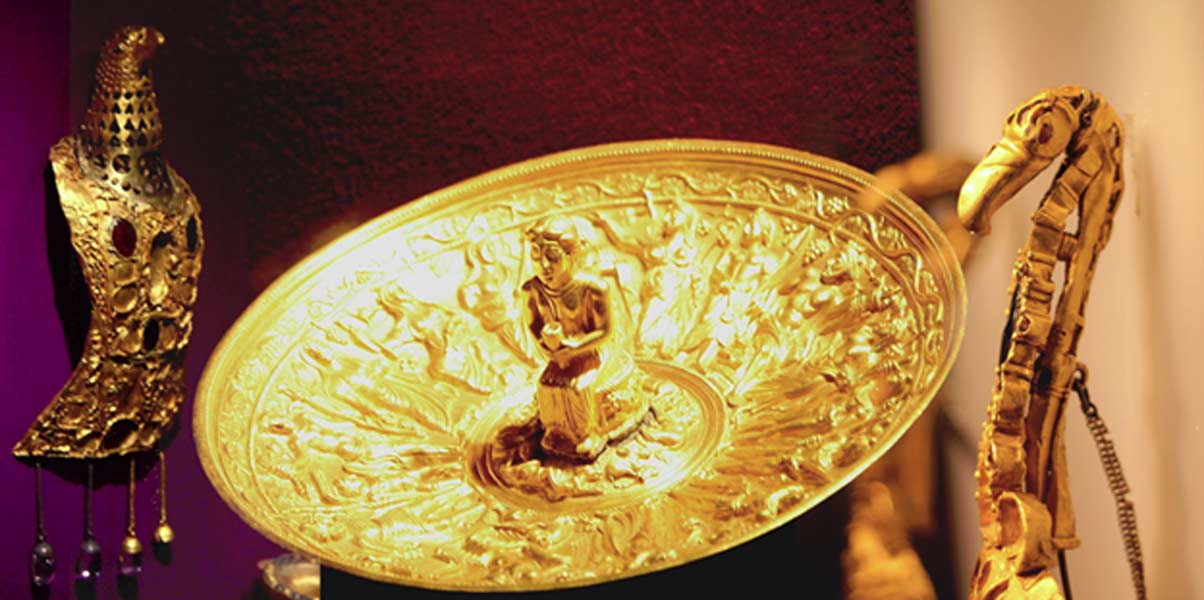The Pietroasele Treasure is the name given to a hoard of gold artifacts discovered during the 19th century. These precious objects were discovered in an ancient grave in Pietroasele, Buzău County, Romania. The gold artifacts have been dated to the Gothic period, specifically between the late 4 th century AD and the middle of the 5 th century AD. One factor contributing to the importance of the Pietroasele Treasure is that its objects allow us to gain some understanding of Gothic society during that period of time. As an example, the Ring of Pietroasele (known also as the Buzău torc) has been found to have contained runic inscriptions, which shed some light on the pre-Christian religious belief of the Goths.
According to some sources, in 1837, two peasants from the village of Pietroasele, Ion Lemnaru and his father-in-law, Stan Avram, were cutting limestone in a quarry for the building of a bridge. Whilst they were doing so, the two men discovered a hoard of 22 gold artifacts. Apart from the Ring of Pietroasele, other notable objects in the Pietroasele Treasure include a patera (a shallow bowl used for libations), a large eagle-headed fibula (a brooch or pin used to fasten garments) encrusted with semi-precious stones, and a twelve-sided cup.

Eagle-shaped middle fibulae, worn in pairs by gothic women ( CC BY-SA 3.0 )
- A Peek into The Paranormal Activity at Haunted Castles in Romania
- Gifts for the Gods? Over 350 Artifacts Discovered in Transylvania Begin to Provide Details on Ancient Trade Routes
- Vlad the Impaler the Inspiration Behind Count Dracula
It has been reported that the two peasants kept the gold objects, and then sold them to an Albanian merchant. One of the things that this merchant did when he had bought the treasure was to break some of the objects into smaller pieces, in order to sell them without being detected by the authorities. It was only a year later, in 1838, that information about this treasure reached the relevant authorities, and the objects were seized. Of the 22 initial pieces, however, only 12 of them were salvaged. Today, the Pietroasele Treasure is kept in the National Museum of Romanian History in Bucharest.

National Museum of Romanian History ( CC BY-SA 3.0 ro )
It has been said to that, according to earlier opinion, the Pietroasele Treasure was linked to the overthrow of the Goths in the region by the Huns around 370 AD. Today, however, this date is regarded as being too early, and it is generally accepted that the objects were accumulated between the late 4 th century AD and early 5 th century AD, and then buried around the middle of the latter century. Some have suggested that the treasure had once belonged to Athanaric, a leader of the Gothic Tervingi tribe who lived during the 4 th century AD.
Analyses of the gold objects have provided an insight into the life of the Goths during that period of their history. For example, a number of figures may be seen on the patera. These figures, dressed in Greek clothing, are thought to be Gothic deities, and are surrounding a female figure, believed to represent a fertility goddess. One of these gods, for example, is depicted holding a club and cornucopia, and may be identified at first glance as Heracles. On closer inspection, one may realize that this god is seated on a throne in the form of a horse’s head, indicating that he is more likely to be Donar, a Germanic god. Other figures, however, are more difficult to identify.
- Exposing the Secret History of Giants and the Underground Hyperborean Gallery in Romania
- Mythology in Romania: Exploring Beliefs about Witchcraft and the Devil
- Confronting the Evil Dead: Terrifying Ancient Beliefs Still Alive in Present-Day Romania – Part I

The gold patera ( CC BY 3.0 )
Apart from artistic representations of deities, Gothic religious belief can also be seen in other aspects of the treasure. The inscriptions of the Ring of Pietroasele are one such example. This neck ring (known also as a torc) contains runic symbols, which have been identified as belonging to the Elder Futhark alphabet. Whilst scholars have attempted to translate the inscription on the ring, there is no consensus as to what it means. Nevertheless, it has been suggested that the runes were meant to provide some sort of magical protection to its wearer.

A drawing of the Ring of Pietroasele. ( Public Domain )

No comments:
Post a Comment